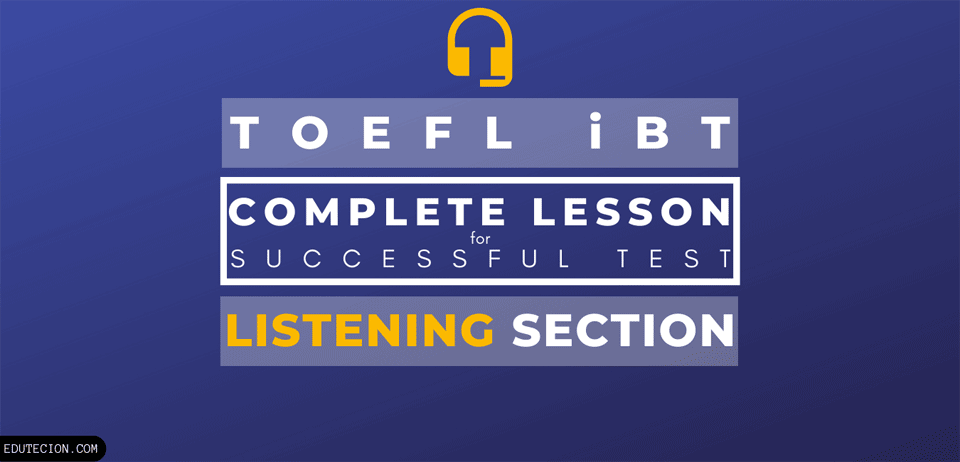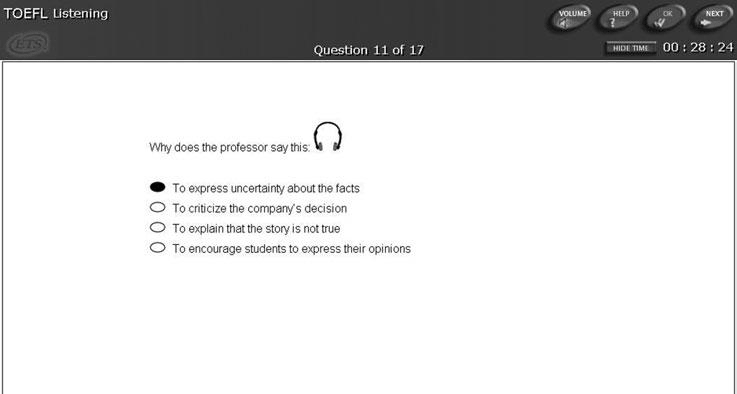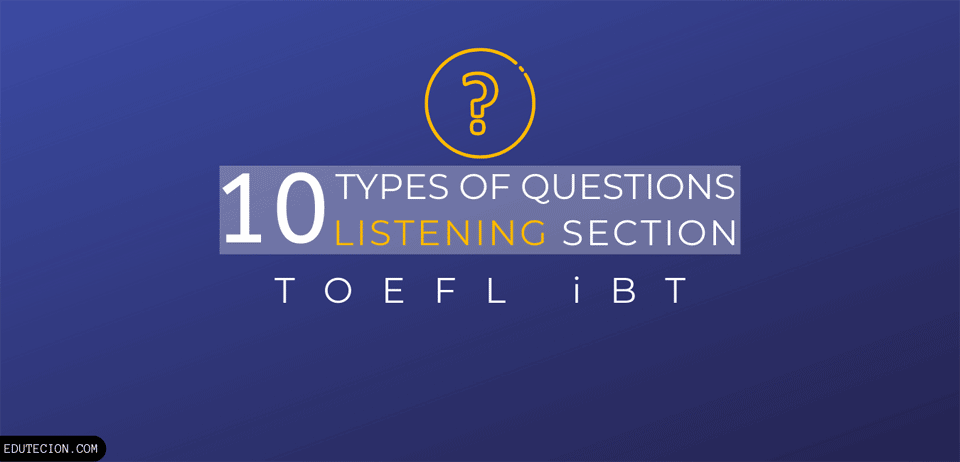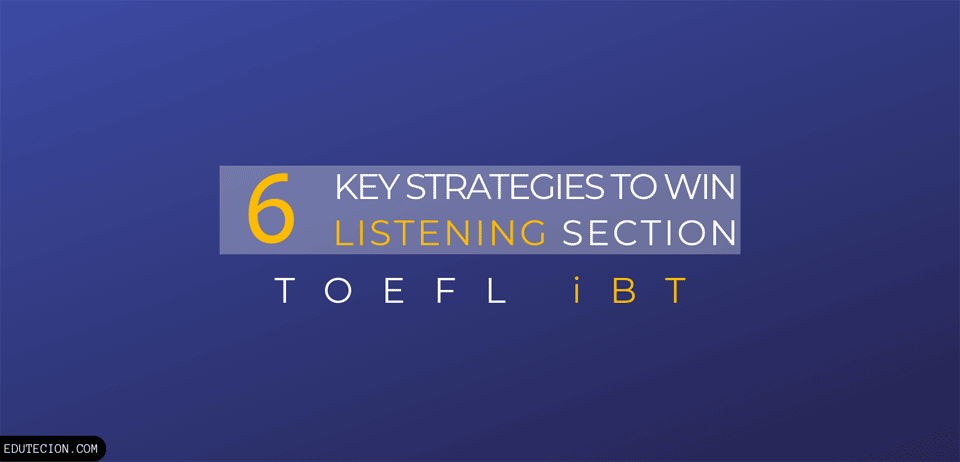6 Most Effective Strategies for Listening Section of TOEFL iBT (UPDATED 2024)
Are you struggle to find the most effective strategies for listening section of toefl ibt? Here, you can learn about them to score well for free.

Most Effective Strategies for Listening Section of TOEFL iBT – In TOEFL iBT, the listening section examines your ability to comprehend non-written or spoken English. You will listen to types of communications and academic talks at some university settings. Thus listening to discussions, lectures, and conversations between a professor and students in the class, or a student to another student are common during this section.
As you know, answering the multiple-choice questions that asking about particular information stated or implied in each that discussion, lecture, and conversation is your main duty.
Remember, you CAN’T replay each listening passage – it plays only once. So, you need to listen attentively and you should take notes while listening.
Did you know?
Those amazing techniques are superb!
The test supervisor always provides you with papers and a pencil or pen for note-taking and headset with mic to put on your head for the listening and speaking section.
Well, if you’re here to prepare for the test or looking for the lessons about how to win the TOEFL iBT test, you’re at the right place.
In this lesson, I write complete lessons and key strategies to win the listening section of TOEFL iBT.
You can continue the reading to extend your knowledge and refine your preparation for the test.
I also provide a table of contents to help you navigate all the drills easier.
So, are you ready? Let’s dig in!
Table of Contents 📚
Formats in the Listening Section of TOEFL iBT
The listening section has two formats – short and long. In the short format, you listen to two conversations, lectures, and discussions. Meanwhile, you listen to three conversations, lectures, and discussions in the long format. After listening to each passage, you have to answer 5 – 6 questions about it.
Additionally, you will have 5 listening passages. There will be more academic lectures than conversations. Each academic lecture has 6 listening questions and each conversation has 5 listening questions.
As you know the formats in the listening section of TOEFL iBT, you also need to be familiar with the method of answering the questions.
I present them below. Let’s jump right in!
How to Answer Questions in the Listening Section of TOEFL iBT
All you can trust while answering questions in the listening section of TOEFL iBT is your hearing. So, taking notes about important points stated and implied by speakers or lecturers in the listening passage is super helpful.
Look, you need to take notes during this session because you can’t replay once that passage ends. Yeah, I mentioned it twice, so you pay attention.
After that passage ends, the questions on the screen will appear one by one on your command. So, the answers to those questions are based on information in that listening passage.
Keep in mind:
You need to remember important information from the listening passage and take notes to avoid missing information.
Did you know?
You’ll see something like this on your screen during the listening section in the TOEFL iBT test.

As you can see, there are only four control buttons on the top right corner – VOLUME, HELP, OK, and NEXT. I describe the function of each button to help you completing the listening section successfully. Check them out!
- VOLUME
You can turn up or turn down the level of volume of listening passage by clicking this button.
- HELP
You can show computer-assisted help regarding the listening section by clicking this button.
- OK
You click this OK button to confirm your answer before moving to the next question.
- NEXT
You click this NEXT button to move to the next question. Remember, make sure you choose the right answer because you can’t go back to the previous question once you’ve clicked the OK button.
Now, you know the practical ways to answer every question in the listening section of TOEFL iBT. Now, you should also know about how long it takes to complete the listening section.
Check them out!
How Long Listening Section in TOEFL Takes
The listening section divides into two sets. Each set carries one conversation, one lecture, and one discussion. You have 20 minutes to answer all of the questions in the short format and 30 minutes in the long format.
Also, a timer on the screen will tell you how much the remaining time you have.
It starts ticking when listening passage ends and while you’re answering the questions.
Furthermore, you need to complete all questions within 41 – 57 minutes.
Keep in mind:
If you get 5 listening passages, the total time permitted is 41 minutes. The listening section can have up to 7 passages with a total time of 57 minutes.
Now, many candidates of test-takers looking for types of questions in the listening section of TOEFL iBT. They want to be familiar with the test questions. So, they can prepare well for the test.
How about you?
That’s why I list types of questions so you can discern its patterns and acknowledge what to do while answering the questions in the real test.
Are you ready? Let’s jump in!
Types of Questions in the Listening Section of TOEFL iBT

Knowing types of questions that are most regularly tested in the listening section of TOEFL iBT is a lifesaver. So you can focus and spend energy on what required effectively and efficiently.
That’s why many candidates of test-takers seek these types of questions actively. Some pay more extra money to take the TOEFL preparation course in the institutions. And some use only a little time to discover a hidden gem on the internet about TOEFL preparation for free.
Accordingly, I write these lessons to help you and other candidates of test-takers to prepare well for the test. Look, I apprehend the struggle and how abundant money to spend.
If you need to get the best TOEFL score for studying in your dream university, getting a scholarship, professional certificate, or working abroad, you must be familiar with these types of questions.
Are you ready? Let’s get started!
As I mentioned earlier, there are two sets of listening sections – conversation and lecture. It’s easy to differentiate.
Conversation
A conversation listening passage contains two persons who actively speaking with one and another in the college campus for 3 minutes.
For conversation, you can note the types of questions that arise after the passage.
- Detail (Very High)
Detail questions ask you to choose from four possible answers about specific information in the conversation.
You will most likely meet this type of question as it has a very high-frequency level to rise after each conversation listening passage.
- Inference (Very High)
Inference questions require you to draw a conclusion based on information in the conversation.
You need to gather information using Five Ws and How (5W1H).
For instance:
Who are the speakers?
What are they talking about?
When does that conversation happen?
Where does it happen?
Why are they talk about it?
How is the result of that conversation?
Be sure to anticipate other forms of information that 5W1H can generate based on the conversation.
I know it’s a bit hard to remember. That’s why you should write it down on the given papers.
- Pragmatic (Very High)
Pragmatic questions ask you to understand the function of language on a level deeper than the surface meaning.
You need to comprehend the purpose, motivation, attitude, or doubt about a particular point in the conversation.
Commonly, this type of question will provide you a fragment where that particular point replays for the question.
- Purpose (Average)
Purpose questions ask you to identify the purpose of why the speakers having a conversation and why the professor presenting a material.
You need to get the implied meaning of the conversation or the lecturer.
You have to choose one most accurate from four possible reasons.
Lecture
A lecture listening passage includes a professor in the college classroom explaining a particular topic such as natural sciences, social sciences, humanities, or arts for 6 minutes.
Let’s check the types of questions that appear after each lecture listening passage.
- Main Idea (High)
Main idea questions challenge you to name the topic of the lecture.
See, as a lecture listening passage can be 6 minutes long, you need to take notes about important information. By rereading your notes while answering this type of question, you can get the correct answer.
- Organization (Average)
Organization questions demand you to identify the rhetorical composition of a lecture listening passage.
You need to understand the chronological order, steps in sequence, comparison, or cause and effect of that lecture.
- Details (Average)
Details questions also appear in the lecture listening passage (not only in the conversation listening passage).
Here, it’s a bit different because you need to choose three correct answers from six possible options.
That’s is why you need to take notes clearly about the information that potentially tested.
- The technique (Average)
Technique questions urge you to distinguish the way that a professor addresses a point.
Keep in mind, you need to comprehend whether that professor addresses a point by providing definition, giving example, referring sources, or comparing.
See, taking notes about that lecture listening passage helps you again.
- Yes-No (Average)
Yes-no questions are unique because they request you to check a list of statements in a table as either YES or NO.
So, you need to distinguish which statement matches the information in the lecture and which one that opposes.
Now you know, how advantageous note-taking.
- Connection (Average)
Connection questions are quite similar to yes-no questions. They request you to match the list of phrases or sentences with provided categories in a table.
So, you have to relate each phrase or sentence with a suitable category, process, or relationship based on information from the lecture listening passage.
Well, that’s all about types of questions that most frequently tested in the listening section of TOEFL iBT.
I also present key strategies for you to win this section below.
Are you interested?
Let’s go!
Most Effective Strategies for Listening Section of TOEFL iBT

- Prepare like Arthur Bishop
Honestly, I recognize the phrase of victory loves preparation by watching The Mechanic movie starring Jason Statham.
Yeah, I know. It’s a great movie. But, if you’ve not watched it yet. I highly recommend it.
That’s is also why I put it here as a reference for the preparation.
See, with well-preparation you can do anything just like Arthur Bishop in that movie.
I won’t spoil that movie, so I get back to the topic. Cheers!
Look, what I am trying to tell you is you need to get organized before and during the test to get the best outcomes.
Now, you can learn the lessons to be familiar with the sections of the test, formats of each section, types of questions, and key strategies to win the test.
During the test, you also equally need to prepare well. You need to prepare yourself to listen well by adjusting the volume for all listening passages.
I highly recommend you to adjust it before the directions and the test begins. So, you can focus on listening without readjusting it during the listening section of the TOEFL iBT test.
- Laser Focus
The introduction of each conversation and lecture contain important information. So, focus on that introduction is pivotal.
By focusing on the introduction, you get what each listening passage is about. And you can prepare your mind for it.
- Eagle Eyes
During listening to each passage whether it’s a conversation or lecture, the screen provides pictures or other visuals to draw context for that listening passage.
Commonly, you will see pictures of people like in a particular room or college classroom. Also, other visuals like objects, charts, and art support the meaning of a conversation and lecture.
Keep in mind:
Keep your eagle eyes more on the visuals that appear during the conversation or lecture than pictures of people. Also, keep the balance between listening and focusing on visuals. So, you won’t miss important information from the passage.
Use the visuals to enhance your comprehension of each listening passage.
- Read while Listen like Pro
After each listening passage ends, the questions will appear one by one. So, you will hear each question and see the text on the screen.
The key is to stay synchronized.
You need to listen to each question and read the instruction and the possible answers.
- Be a Super Listener
Look, what I mean by being a super listener is listen actively not passively. You need not only to listen plainly but also understand the speaker’s attitude and the nature of the information – a fact or opinion.
It helps to get implied meaning as additional to stated information you’ve heard. See, this strategy supports you to get the correct answers for many types of questions.
- Be Master of Your Mind
Remember, you can’t control the test environment, but you can master your mind. Sometimes, the environment in the test room is not ideal for you to focus on listening and answering the questions.
Other test-takers sometimes make noise that can distract your focus. Like sounds of scratch while others taking notes or other sounds they make that you don’t expect all at.
Situations like that, increase your negative thought and decrease your locus. So, don’t let those emotions interfere with your concentration.
Did you know?
You can practice overcoming this expected situation by doing test practice in a place where people are studying like a library, study lounge, or dormitory.
Well, that’s all the key strategies to win the listening section of TOEFL iBT.
Let’s recap what have you learned by checking the conclusion below.
Conclusion
Listening is the second section you will face in TOEFL iBT. It tests your ability to perceive spoken English. Most of the listening passages are like the real situation of any conversation and lecture in university settings.
You can prepare well for the test by studying about formats of the listening section, types of questions, and key strategies to win it. During the test, you will listen to the listening passages wearing the provided headset. On the screen, you will only see brief instructions of questions and possible answers to those questions. Getting yourself ready for the test is pivotal.
I know you can do it!
Congratulation! you have completed this lesson. I hope you find it helpful. If you have any questions regarding this lesson, feel free to mention it in the comment. Also, you can share the effective strategies that you used to win the listening section in TOELF iBT previously, so others can learn more. Cheers!